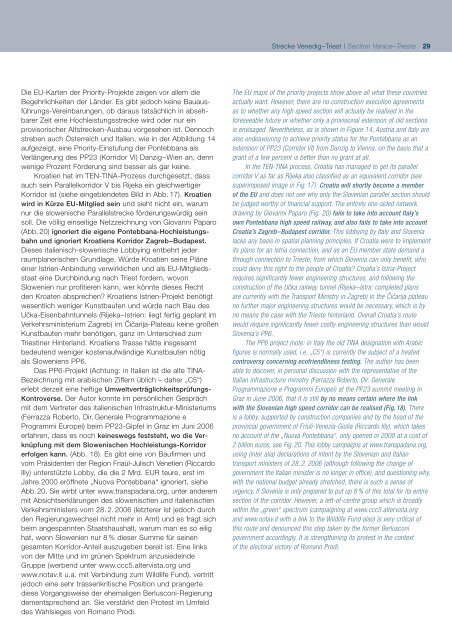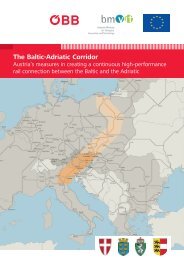Inhalt | Contens - baltic-adriatic.eu
Inhalt | Contens - baltic-adriatic.eu
Inhalt | Contens - baltic-adriatic.eu
Sie wollen auch ein ePaper? Erhöhen Sie die Reichweite Ihrer Titel.
YUMPU macht aus Druck-PDFs automatisch weboptimierte ePaper, die Google liebt.
Die EU-Karten der Priority-Projekte zeigen vor allem die<br />
Begehrlichkeiten der Länder. Es gibt jedoch keine Bauausführungs-Vereinbarungen,<br />
ob daraus tatsächlich in absehbarer<br />
Zeit eine Hochleistungsstrecke wird oder nur ein<br />
provisorischer Altstrecken-Ausbau vorgesehen ist. Dennoch<br />
streben auch Österreich und Italien, wie in der Abbildung 14<br />
aufgezeigt, eine Priority-Einstufung der Pontebbana als<br />
Verlängerung des PP23 (Korridor VI) Danzig–Wien an, denn<br />
wenige Prozent Förderung sind besser als gar keine.<br />
Kroatien hat im TEN-TINA-Prozess durchgesetzt, dass<br />
auch sein Parallelkorridor V bis Rijeka ein gleichwertiger<br />
Korridor ist (siehe eingeblendetes Bild in Abb. 17). Kroatien<br />
wird in Kürze EU-Mitglied sein und sieht nicht ein, warum<br />
nur die slowenische Parallelstrecke förderungswürdig sein<br />
soll. Die völlig einseitige Netzzeichnung von Giovanni Paparo<br />
(Abb. 20) ignoriert die eigene Pontebbana-Hochleistungsbahn<br />
und ignoriert Kroatiens Korridor Zagreb–Budapest.<br />
Dieses italienisch-slowenische Lobbying entbehrt jeder<br />
raumplanerischen Grundlage. Würde Kroatien seine Pläne<br />
einer Istrien-Anbindung verwirklichen und als EU-Mitgliedsstaat<br />
eine Durchbindung nach Triest fordern, wovon<br />
Slowenien nur profitieren kann, wer könnte dieses Recht<br />
den Kroaten absprechen? Kroatiens Istrien-Projekt benötigt<br />
wesentlich weniger Kunstbauten und würde nach Bau des<br />
Učka-Eisenbahntunnels (Rijeka–Istrien: liegt fertig geplant im<br />
Verkehrsministerium Zagreb) im Čičarija-Plateau keine großen<br />
Kunstbauten mehr benötigen, ganz im Unterschied zum<br />
Triestiner Hinterland. Kroatiens Trasse hätte insgesamt<br />
bed<strong>eu</strong>tend weniger kostenaufwändige Kunstbauten nötig<br />
als Sloweniens PP6.<br />
Das PP6-Projekt (Achtung: in Italien ist die alte TINA-<br />
Bezeichnung mit arabischen Ziffern üblich – daher „C5“)<br />
erlebt derzeit eine heftige Umweltverträglichkeitsprüfungs-<br />
Kontroverse. Der Autor konnte im persönlichen Gespräch<br />
mit dem Vertreter des italienischen Infrastruktur-Ministeriums<br />
(Ferrazza Roberto, Dir. Generale Programmazione e<br />
Programmi Europei) beim PP23-Gipfel in Graz im Juni 2006<br />
erfahren, dass es noch keineswegs feststeht, wo die Verknüpfung<br />
mit dem Slowenischen Hochleistungs-Korridor<br />
erfolgen kann. (Abb. 18). Es gibt eine von Baufirmen und<br />
vom Präsidenten der Region Friaul-Julisch Venetien (Riccardo<br />
Illy) unterstützte Lobby, die die 2 Mrd. EUR t<strong>eu</strong>re, erst im<br />
Jahre 2000 eröffnete „Nuova Pontebbana“ ignoriert, siehe<br />
Abb. 20. Sie wirbt unter www.transpadana.org, unter anderem<br />
mit Absichtserklärungen des slowenischen und italienischen<br />
Verkehrsministers vom 28. 2. 2006 (letzterer ist jedoch durch<br />
den Regierungswechsel nicht mehr in Amt) und es fragt sich<br />
beim angespannten Staatshaushalt, warum man es so eilig<br />
hat, wenn Slowenien nur 8 % dieser Summe für seinen<br />
gesamten Korridor-Anteil auszugeben bereit ist. Eine links<br />
von der Mitte und im grünen Spektrum anzusiedelnde<br />
Gruppe (werbend unter www.ccc5.altervista.org und<br />
www.notav.it u.a. mit Verbindung zum Wildlife Fund), vertritt<br />
jedoch eine sehr trassenkritische Position und prangerte<br />
diese Vorgangsweise der ehemaligen Berlusconi-Regierung<br />
dementsprechend an. Sie verstärkt den Protest im Umfeld<br />
des Wahlsieges von Romano Prodi.<br />
Strecke Venedig–Triest | Section Venice–Trieste 29<br />
The EU maps of the priority projects show above all what these countries<br />
actually want. However, there are no construction execution agreements<br />
as to whether any high speed section will actually be realised in the<br />
foreseeable future or whether only a provisional extension of old sections<br />
is envisaged. Nevertheless, as is shown in Figure 14, Austria and Italy are<br />
also endeavouring to achieve priority status for the Pontebbana as an<br />
extension of PP23 (Corridor VI) from Danzig to Vienna, on the basis that a<br />
grant of a few percent is better than no grant at all.<br />
In the TEN-TINA process, Croatia has managed to get its parallel<br />
corridor V as far as Rijeka also classified as an equivalent corridor (see<br />
superimposed image in Fig. 17). Croatia will shortly become a member<br />
of the EU and does not see why only the Slovenian parallel section should<br />
be judged worthy of financial support. The entirely one-sided network<br />
drawing by Giovanni Paparo (Fig. 20) fails to take into account Italy’s<br />
own Pontebbana high speed railway, and also fails to take into account<br />
Croatia’s Zagreb–Budapest corridor. This lobbying by Italy and Slovenia<br />
lacks any basis in spatial planning principles. If Croatia were to implement<br />
its plans for an Istria connection, and as an EU member state demand a<br />
through connection to Trieste, from which Slovenia can only benefit, who<br />
could deny this right to the people of Croatia? Croatia’s Istria-Project<br />
requires significantly fewer engineering structures, and following the<br />
construction of the Učka railway tunnel (Rijeka–Istra: completed plans<br />
are currently with the Transport Ministry in Zagreb) in the Čičarija plateau<br />
no further major engineering structures would be necessary, which is by<br />
no means the case with the Trieste hinterland. Overall Croatia’s route<br />
would require significantly fewer costly engineering structures than would<br />
Slovenia’s PP6.<br />
The PP6 project (note: in Italy the old TINA designation with Arabic<br />
figures is normally used, i.e. „C5“) is currently the subject of a heated<br />
controversy concerning ecofriendliness testing. The author has been<br />
able to discover, in personal discussion with the representative of the<br />
Italian infrastructure ministry (Ferrazza Roberto, Dir. Generale<br />
Programmazione e Programmi Europei) at the PP23 summit meeting in<br />
Graz in June 2006, that it is still by no means certain where the link<br />
with the Slovenian high speed corridor can be realised (Fig. 18). There<br />
is a lobby, supported by construction companies and by the head of the<br />
provincial government of Friuli-Venezia-Giulia (Riccardo Illy), which takes<br />
no account of the „Nuova Pontebbana“, only opened in 2000 at a cost of<br />
2 billion <strong>eu</strong>ros, see Fig. 20. This lobby campaigns at www.transpadana.org,<br />
using (inter alia) declarations of intent by the Slovenian and Italian<br />
transport ministers of 28. 2. 2006 (although following the change of<br />
government the Italian minister is no longer in office), and questioning why,<br />
with the national budget already stretched, there is such a sense of<br />
urgency, if Slovenia is only prepared to put up 8 % of this total for its entire<br />
section of the corridor. However, a left-of-centre group which is broadly<br />
within the „green“ spectrum (campaigning at www.ccc5.altervista.org<br />
and www.notav.it with a link to the Wildlife Fund also) is very critical of<br />
this route and denounced this step taken by the former Berlusconi<br />
government accordingly. It is strengthening its protest in the context<br />
of the electoral victory of Romano Prodi.



